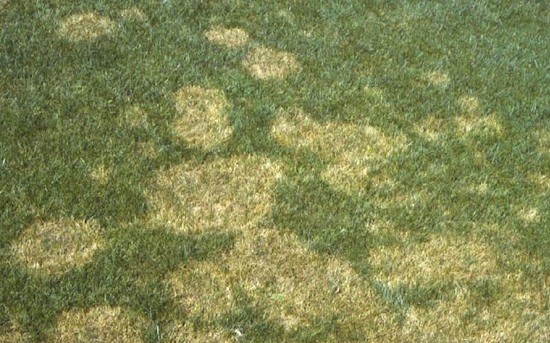If doughnut-shaped rings of dead grass are popping up in your lawn, it may be because the recent onslaught of rain created ideal conditions for brown patch disease
Brown patch on turfgrass is caused by a fungal disease known as Rhizoctonia solani. Circular patches of dead grass that range from a few inches to several feet in diameter occur during periods of high humidity and warm temperatures (75ºF to 85ºF).
It loves humid summers
Georgia's summer climate is ideal for this fungus. Brown areas of dead grass are surrounded by a reddish-brown or purplish halo. After two to three weeks, the center area of the brown grass may recover and turn green, resulting in a doughnut shape of dead brown grass.
This common lawn disease is prevalent during warm, humid summer months. It attacks all turfgrasses including bermudagrass, tall fescue, centipedegrass and zoysiagrass. This time of year it affects tall fescue the most. Some varieties of these grasses are resistant or less susceptible to the disease, but none are totally immune.
Conditions that favor brown patch include excessive nitrogen fertilizers, frequent watering, watering late in the day (or too much rain) and high humidity.
Follow these tips
To help prevent brown patch, don't apply excessive amounts of nitrogen fertilizers. Use only enough fertilizer to maintain a reasonably healthy, green turfgrass based on a soil test. Excessive nitrogen tends to favor the development of brown patch due to lush, tender growth of grass that is more susceptible to attack by the fungus.
Water early in the morning to allow grass foliage to dry before nightfall. Most fungi grow and develop during the night when given adequate moisture. It’s best to water lawns early in the morning, less often and more deeply. Turfgrass needs approximately 1 inch of water per week, ideally given in one or two applications. With all the rain this year, no one should need to water their lawn. If you’re watering your lawn this summer, you’re probably watering too much.
Mow the lawn slightly higher than normal during periods of excessively high heat conditions. This reduces stress to turfgrasses and helps reduce the possibility of disease. Common turfgrasses and their recommended mowing heights are as follows: bermudagrass - 1 to 1.5 inches; centipedegrass - 1 to 2 inches; St. Augustinegrass - 2 to 3 inches; zoysiagrass - 1 to 2 inches; and tall fescue - 2 to 3 inches. Tall fescue, especially, performs better when kept at a taller height in the summertime.
Avoid or remove excess thatch from the lawn. Thatch is decomposing grass stems, shoots and roots — not clippings — that have accumulated at the soil surface. More than half an inch of thatch will retain excess moisture and favor disease development. Thatch buildup can be caused by improper mowing practices and over-fertilization.
Mow your lawn often enough that no more than one-third of the grass height is removed in a single mowing. This may require mowing as often as once or twice a week, which can be a challenge with all the rain we’ve been getting. Keep your mower blades sharp and don’t mow grass when wet.
Dethatching machines (vertical mowers and core aerators) can be rented for use on lawns that have accumulated too much thatch. This should only be done in early summer for warm-season turfgrasses and in the fall for tall fescue. Bagging grass clippings is usually not necessary if you are mowing your grass frequently enough and following recommended fertilization practices for your turfgrass. (For more information on grasscycling, see the University of Georgia Cooperative Extension publication website at www.caes.uga.edu/publications/.
Bring in a sample
If you think you have brown patch or any other diseases in your lawn, bring a sample of the turfgrass (about a 4x4 inch square, including the roots) to your local UGA Extension office for proper diagnosis. An ideal sample for diagnosis is half dead and half alive, taken from the outer edge of a dead patch. A fungicide recommendation may be required if the problem cannot be corrected with cultural practices.








